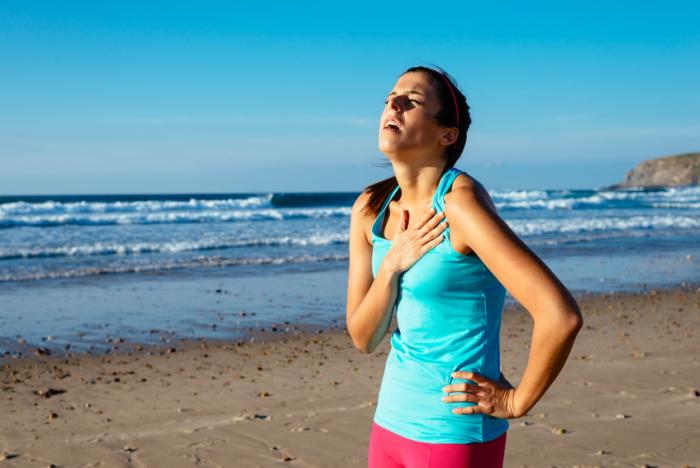If you’ve ever felt the tightness in your chest or the shortness of breath that comes with exercise-induced asthma, you know how frustrating it can be. But fear not, there are natural ways to manage and alleviate these symptoms. With the right approach, you can continue to enjoy your workouts without the worry of asthma flare-ups holding you back. In this blog post, we will share some effective strategies to help you breathe easier and conquer your exercise routine with confidence.

Contents
- 1 How To Treat Exercise-Induced Asthma Naturally?
- 2 What Are The Symptoms Of Exercise-induced Asthma?
- 3 What Causes Exercise-induced Asthma?
- 4 Frequently Asked Questions
- 4.1 How can breathing through the mouth trigger exercise-induced asthma?
- 4.2 Why does the intensity of exercise play a role in triggering exercise-induced asthma?
- 4.3 What tests are recommended to assess lung function before and after exercise challenges?
- 4.4 How do environmental factors like cold air, pollen, and pollution contribute to exercise-induced asthma symptoms?
How To Treat Exercise-Induced Asthma Naturally?
Treating exercise-induced asthma (EIA) naturally involves strategies to reduce inflammation, improve lung function, and manage symptoms. Consider these approaches:
What Are The Symptoms Of Exercise-induced Asthma?
Exercise-induced asthma (EIA), also known as exercise-induced bronchoconstriction (EIB), is a condition where your airways narrow during or after exercise. This narrowing makes it difficult to breathe and can cause a variety of symptoms. Here are the main ones to watch out for:
- Shortness of breath: This is the most common symptom of EIA and often feels like you’re not getting enough air into your lungs. You might feel breathless during exercise or even after you’ve stopped.
- Wheezing: This is a whistling sound that occurs when you breathe due to the narrowing of your airways. It can be a scary symptom, but it doesn’t necessarily mean you have a serious condition.
- Chest tightness: This can feel like a band is squeezing around your chest, making it difficult to take a deep breath.
- Coughing: A dry cough that occurs during or after exercise can be a sign of EIA.
These symptoms typically appear within 5 to 20 minutes of starting exercise and can last for up to an hour after you stop. In some cases, symptoms might not appear until later in the evening after exercise.

Here are some other points to consider:
- Severity: Symptoms of EIA can range from mild to severe. Some people might only experience slight shortness of breath, while others may have difficulty breathing and wheeze significantly.
- Triggers: Cold, dry air is a common trigger for EIA. Other triggers can include exercise intensity, air pollution, and allergens like pollen.
- Not everyone with exercise-induced symptoms has EIA: Other conditions can cause similar symptoms during exercise, so it’s important to see a doctor for proper diagnosis.
What Causes Exercise-induced Asthma?
Exercise-induced asthma (EIA) occurs when physical activity triggers airway constriction and inflammation in susceptible individuals. Several factors contribute to the development of EIA:
1. Airway Sensitivity::
In individuals with EIA, the airways are overly sensitive to changes in temperature, humidity, and the volume of air breathed in during exercise. This sensitivity leads to the narrowing of the airways, making it difficult to breathe.
2. Dehydration::
Exercise can lead to dehydration, causing the airways to become dry and irritated. Dehydrated airways are more prone to inflammation and bronchoconstriction in response to exercise.
3. Cool, Dry Air::
Exercising in cold, dry air can trigger EIA symptoms in some individuals. Cold air causes the airways to constrict, while dry air can dehydrate the airway lining, exacerbating inflammation and bronchoconstriction.
4. High-Intensity Exercise::
Activities that involve prolonged or intense exertion, such as running or competitive sports, are more likely to trigger EIA symptoms. The increased demand for oxygen during high-intensity exercise can lead to rapid breathing, which may aggravate airway sensitivity.

5. Allergens and Pollutants::
Exposure to allergens such as pollen, dust, or pet dander, as well as air pollutants like ozone or particulate matter, can exacerbate EIA symptoms during exercise. These environmental triggers can induce airway inflammation and increase the risk of bronchoconstriction.
6. Underlying Inflammation::
Individuals with underlying airway inflammation, such as those with asthma or allergic rhinitis, are more susceptible to EIA. Exercise can further exacerbate this inflammation, leading to heightened airway reactivity and symptoms.
7. Respiratory Infections::
Respiratory infections, such as the common cold or flu, can increase airway inflammation and sensitivity, making individuals more prone to EIA during and after exercise.
Frequently Asked Questions
How can breathing through the mouth trigger exercise-induced asthma?
Breathing through the mouth during exercise bypasses the natural airway warming and humidification processes of breathing through the nose, causing the muscle bands around the airways to contract in response to colder and drier air, narrowing the airway.
Why does the intensity of exercise play a role in triggering exercise-induced asthma?
High-intensity workouts can stress the airways further, making them more sensitive to changes in temperature and humidity when breathing through the mouth, leading to increased likelihood of asthma symptoms.
What tests are recommended to assess lung function before and after exercise challenges?
Spirometry tests are recommended to assess lung function before and after exercise challenges to evaluate the impact of exercise on the airways and help in diagnosing and managing exercise-induced asthma.
How do environmental factors like cold air, pollen, and pollution contribute to exercise-induced asthma symptoms?
Environmental factors like cold air, pollen, and pollution can irritate the airways and trigger asthma symptoms during exercise by exacerbating the sensitivity of the muscle bands around the airways to temperature and humidity changes.

Hello, I’m Ravindra. Over the years, I’ve immersed myself deeply into the world of fitness and health, transforming both my body and mind. Writing has allowed me to share my journey, insights, and expertise with those just starting out and seasoned fitness enthusiasts alike. Beyond just routines and diets, I believe in inspiring others to adopt a holistic approach to well-being.

